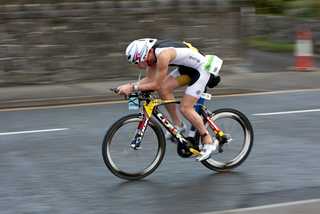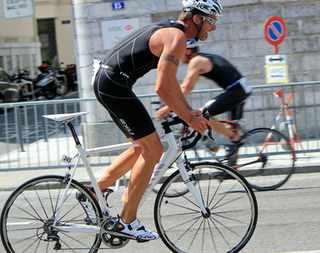The Triathlon Bike Stage
Half the Race
Worth the Effort
The triathlon bike stage takes up approximately half the time of the race. Quite a bit of time can be gained or lost on this stage and, therefore, it makes sense to be well prepared.
This starts with the selection of bike. Maybe you already have a bike that you are used to, even if you don't ride too often. If this is a road or mountain bike, and not a 'sit up and beg' bike with a basket on the front, it will be fine for your first triathlon.
After you have 'got the bug' and start entering more triathlons you may want to upgrade a little. Unless you are becoming really serious about triathlons, your triathlon bike doesn't need to cost a fortune.
You may well know quite a bit about bikes in which case you are capable of making your own decisions about bike choice. If, however, you are like me when I first started and only just about knew one end of the bike from the other, you will need advice.
This advice can come in several forms. If you have joined a local tri club, there will be plenty of fellow triathletes available to help you. If you have yet to join, then maybe you have a friend who is very knowledgable. Failing that it would be best to go to your local bike store for advice.
It is in their interest to help you and they would ensure that you get the correct size bike at the right price for you. They are also there in the future should you need any further servicing or advice.
Right! You have your bike and your first triathlon is looming on the horizon.
There are many ways that we can improve our time over the triathlon bike stage. Assuming that your bike has been set up correctly by the bike store lets look at how we can cycle faster!
All sorts of research has been done as to the most efficient aerodynamics and biomechanics of cycling, and this has proven that the incorrect body position can cost quite a lot of time and energy. As drafting is banned in most triathlon bike stages, an aerodynamic body position is very important.

Your back should be as flat as possible, without over stretching which could lead to cramping.
This lessens the wind resistance experienced when cycling at speed.
As you become more experienced you may want to invest in aero bars to improve your efficiency in this area.
The saddle should be positioned so the legs are slightly bent at the bottom of the pedal stroke. Your legs have most power in this position. It will also help a great deal to get used to pulling the pedal up as well as pushing down. This brings other muscle groups in to help instead of the quads doing all the work!
This leads to the actual pedal cadence. When I first started in triathlons it was a fairly new sport and little real research had been done with regards to training. In fact, I seemed to think it was a 'man thing' to churn out the biggest gear possible. Subsequently, I ended up with a mass of lactic acid in my legs for the start of the run.
How times have changed!
The general thinking nowadays is that a pedal cadence of between 85-100rpm is the optimal range. This should enable a cadence that you are comfortable with, at the same time not reducing the power output. Towards the end of the triathlon bike stage the cadence should increase slightly reducing the force produced by the muscles. This in turn will reduce oxygen consumption and, hopefully, help to avoid you being in the state I used to be in for the start of the run!
This brings us on to training for the triathlon bike ride!
Unless you are a professional rider or retired, you are limited to the amount of time you have for training each week. Combine this with the fact that you are training for three sports, it gives you even less time to spend on your cycle training.
The chances are that, at the most, you will manage three cycle training sessions a week. This means that in order to gain any great benefit they will need to be of fairly high intensity!
This is going to involve a certain mental toughness on your part which you obviously have, otherwise you would just sit and watch television rather than consider doing triathlons!!
Having said that, there will be times when you really don't want to train. We all have them! However, if you can force yourself out on the bike you will feel so much better after and say to yourself 'job well done' rather than beating yourself up for not training.
You may well have routes that you cycle on a regular basis. It is important to vary your weekly training cycles but cycling at high intensity will help build cardio efficiency and, in turn, fatigue resistance at race pace.
The sessions can take various forms mixing longer rides with shorter hill sessions or interval work.
Certainly, the interval and hill training is tough and it is important that you build some base fitness before you start these sessions.
Before your high intensity workout, make sure you warm up for at least ten minutes.
A popular interval workout would be fast one minute intervals followed by one minute spinning of about ten repetitions. Have a rest by spinning for a while and then repeat.
Also, if you you have a circular route of three to five miles you could do timed intervals of this route eg. 3 x three miles or 2 x five miles with around 10 - 15 minutes recovery between. Try to at least cycle at race pace to get your body used to this effort.

For a hill session either choose a hilly route, working the hills and recovering between, or choose a hill and do repetitions of the same hill, again recovering between. This will certainly help you use the hills to your advantage during a race.
Fartlek training is another form of interval work slightly less structured than the other forms. Here you mix high intensity with recovery but more on a random basis, maybe really working a hill, recovering, then several sprints, recovering, followed by a slightly longer time trial effort.
Try and and fit one session a week that is race distance or longer perhaps including two or three good hills, pushing them but not completely shattering yourself.
Try to keep your training consistent. Rather than really struggle through a session then miss the next training ride, just throttle back slightly and train regularly.
During these sessions it is important to get used to drinking on the bike. Hydration will be absolutely vital during the triathlon bike stage of a race. The amount of fluid you will drink will depend on the distance of the race and the temperature but you could well expect to get through 500ml during an hour ride.
During the race it is probably best to get ten minutes into the ride before drinking, just to give you a chance to find your cadence. Then little and often rather than gulping a lot in one go!
Regular, structured training will soon become second nature, then watch your triathlon bike times improve!
Return from the triathlon bike page to Triathlon Club home page
Membership of the Triathlon Club is FREE!
Please join us by signing up for our newsletter which will tell you each month about information we have added to the website!